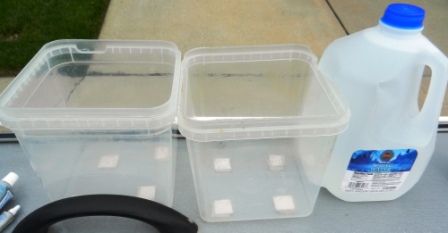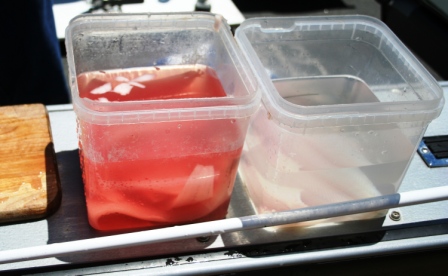Potable Water
Look for Potable Water - at the lake or a campground - free of bacteria and contaminants. The word Potable comes from a Latin word that means "to drink" and Potable is defined in the dictionary as "suitable for drinking". Most cleaning stations will have clean running water available to help rinse away blood and entrails from your fillet board. If not certain, be sure to ask if this water if safe for drinking. There should be signs that will state you are using safe water. If not certain, take along a couple of gallons of spring water from the store with you so that you can rinse your fillets before going home.
 Fresh Potable Water With Two Rinse Containers
Fresh Potable Water With Two Rinse Containers
Optional: Saline Rinse
The term normal saline represents the low concentration of salt (saline) that has been determined that will not harm live tissue when used as a soak or a rinse. Adding too much salt in a rinse can have an ill effect on your fillet by drying it out. However, using a low concentration can assist in removing things that do not taste very good such as slime, skin oil and blood from your fillets. The following process will allow you to make your own normal saline solution to use as you prepare to clean your fish:
How to Make Your Saline Rinse
To Make One Gallon of Saline Rinse:
- Measure 3-4 teaspoonsful of salt
- Place this into One Gallon container of water
- Gently swirl contents until most salt has dissolved
- Your solution is ready to use
If you watch enough medical shows on TV you will hear them talk about normal saline for this or that. The precise mixture and sterility for the hospital is of course not needed for your fish cleaning purposes. The formula above will get you close to the correct solution. This estimate is perfect for this setting. If you would prefer to make a smaller amount of saline rinse, use the formula of 1 level teaspoon per 1 liter or quart of water.
After removing fillets from both sides of the fish, you will need to remove the rib bones, rinse thoroughly with a clean water rinse - potable water. (A normal saline rinse made from potable water works well in this step.) Note in the picture below the amount of excess blood and fish oil that is removed in the first rinse containing the saline rinse compared the second rinse. Gallon freezer bags work well if small containers are not available.
 Initial Rinse: Left / Final Rinse: Right
Initial Rinse: Left / Final Rinse: Right
Back Country Potable Water
Most marinas and fishing lodges provide running water that is safe for human consumption - that is potable water. Plan ahead and know where you will likely clean your fish, and if not certain, bring with you a couple of gallons of spring water purchased from a local grocery store to use for rinsing your fillets. You may be fishing a stream in the back country or perhaps traveling to an area where you the water supply is not treated and it is unhandy to carry clean water with you. Sources of contaminants include fecal contamination of animals or humans, standing water where bacteria can grow, run off from chemicals and perhaps even from dead - decaying animals.
If you need potable water or water for cleaning and preparing a meal there are various methods of making most water safe for human consumption if you follow simple guidelines. Look for a stream or river that has a strong flow of water, this aids in diluting any contaminants.
Use your senses - look and smell. If you can see or smell things that do not look good, then look for better water, running water. Go up stream from where you are. If at a lake look for a stream that feeds the lake. The bigger the lake, the deeper the water and the opportunity for new water to flow into the lake all make for the opportunity to dilute any contaminants and provide a better source of water. Even clean looking water may still have small particles or organisms that could be harmful. Read below for ways to filter the water to make it safe.
The CDC (Center for Disease Control) has published a good summary of the most commonly encountered contaminants Also listed are preferred methods for cleaning water in which they can be found. Click on the attachment below for a handy PDF file from the CDC: Water Treatment for Backcountry and Travel:
Open the link above and print off this excellent one page PDF file for your reference. Summarized below are highlights of what you will find on its contents. There are three primary methods of purifying unsafe water:
Boiling Water
Boiling remains the single most effective method of removing contaminants and making potable water. Raise the temperature of the water to a roaring boil for over at least one minute, and then allow to cool, transfer to a clean, non-contaminated container, in other words not the container that you used to collect your water for boiling. The biggest obstacle is not having a method to raise the temperature of the water to boiling.
Filtering
Filtering Water - even if boiling your water - it is a good idea to first use a simple filter such as a coffee filter or even a cloth like a clean t-shirt when making your own potable water., This will remove larger particulate matter - such as sand or suspended plant matter. Available from most sporting stores are water filters that will filter out up to 0.1 Microns (very small in size) even micro-organisms. Look for the government stamp of approval to certify that the filter you purchase will be effective for you. Filtering out any larger particulate matter first will improve your purchased filter's ability to not get clogged and be able to filter those small organisms.
The filter pictured above is made with 3 filter levels that remove particles and odor as well as the pathogens you definitely want to get rid of. Click on the links above and read if this fine product might be useful for you. The convenient pump handle assists running water through the filter, which can purify up to 2 liters of water per minute, with a capacity of nearly 530 gallons. It can be used with most standard outdoor bottles and hydration bladders.
Chemical Purifying
Chemical Purification - Iodine and Chlorine are the two most commonly used chemicals that will remove specific contaminants. Iodine tablets are available from fine camping and sporting goods stores. Chlorine tablets are also available or you can add 5-6 drops of chlorine bleach per gallon of water to accomplish the same thing. If you choose to do this do not use any bleach that has additives such as scent or color. The above link provides information about one chemical purifying method. When combinded with an MSR filter you can rest assured you are really covered.
The link below shows a micro-filter water filter pump with a replaceable carbon and ceramic filter that removes bacteria, protozoa and virtually all particulate matter. This delivers one liter per minute and actually fits many wide mouth bottles which are sold separately. Each replaceable filter will clean 2,000 liters of water.


